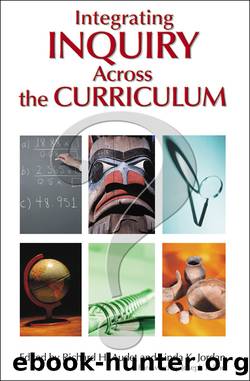Integrating Inquiry Across the Curriculum by Audet Richard H.;Jordan Linda K.;

Author:Audet, Richard H.;Jordan, Linda K.; [Jordan, Linda K.; Audet, Richard H.]
Language: eng
Format: epub
ISBN: 1994296
Publisher: Corwin Press
Published: 2005-04-13T00:00:00+00:00
Language Exploration
Drawing on studentsâ wondering in their reading and writing assignments is another strategy for developing studentsâ communicative and textual competence. Opportunities for students to generate their own topics for writing and select their own materials for reading may be quite limited in the scripted, prepackaged curricula that seem to be burgeoning in the current standardized testing climate found in most schools. To engender inquiry and independent problem solving, teachers can provide time for students to identify questions worth pursuing and topics rich enough for engaging their full efforts in multiple expressive means.
To explore the world of language is to open all kinds of unforeseen doors and windows in studentsâ thinking. As they develop their ability to reflect consciously on their own language use, students gain increased control of the many language tools at their disposal. They begin to realize that we modify the way we speak and write depending on our purpose and audience, and they begin to attend to the often subtle and myriad ways we signal our intentions and form our messages. To engage students in language exploration is to help them design and undertake projects of compelling personal interest.
As in the example provided in the sample lesson for helping students generate topics for writing, teachers can speak aloud to demonstrate their own mental processes for choosing a focus of study. Encouraging students to brainstorm possibilities before making a selection can make the process manageable and create genuine choice for the students. The following are some overlapping guidelines for developing this kind of project.
⢠Start with an individual studentâs personal set of interests. Just about everything in the world incorporates some aspect of language, even if it only involves the way we interpret a phenomenon, such as our response to a soccer game or a rap tune. We use language to describe our reactions and discover what we know. We accomplish this either through dialogue or in writing for a larger audience. In both cases, we are most motivated to formulate our thinking when we are exploring a topic of personal interest.
⢠Projects can be structured as a case study of a particular language user, for example, of a favorite author, a storyteller who is remarkably engaging, a songwriter a student admires, or even a classmate. In that kind of project, students collect samples of the personâs language use, either in writing or in transcripts from tape recordings. They can conduct interviews to delve more deeply into issues that spark their curiosity.
⢠Another learning structure is to have students develop a task or design an experience and document participantsâ responses. In projects of this type, students develop an open-ended, written questionnaire to survey people about their experiences and opinions on a particular topic (e.g., e-mail, slang, poetry); organize a gathering of people to watch video clips and discuss their responses; or engage a group of friends in recounting and recording their stories, possibly prompted by photographs or wordless picture books.
⢠Another kind of project could involve selecting,
Download
This site does not store any files on its server. We only index and link to content provided by other sites. Please contact the content providers to delete copyright contents if any and email us, we'll remove relevant links or contents immediately.
Competing on Culture by VanWagoner Randall;Sydow Debbie L.;Alfred Richard L.;(156)
Teaching Skills For Dummies by Sue Cowley(137)
The Art & Science of Web Design by Jeffery Veen(135)
Maker-Centered Learning by unknow(115)
People Skills by Thompson Neil(112)
Managing Unstoppable Learning by Hierck Tom;(103)
Lorange P. Learning and Teaching Business...Lessons...2022 by Unknown(102)
Motivating Defiant and Disruptive Students to Learn by Rich Korb(101)
The InterActive Classroom by Nash Ron;(97)
Forces of Influence by Ende Fred;Everette Meghan;(96)
Summarization in Any Subject by Wormeli Rick;Stafford Dedra;(95)
Connecting Through Leadership by Kullar Jasmine K.;(93)
Teacher Mentoring and Induction by Portner Hal;(92)
Academic Advising and the First College Year by Jenny R. Fox; Holly E. Martin(91)
Employee of the Month by Tracey Rogers(90)
Reflective Practice in Action by Farrell Thomas S. C.;(87)
What We Say and How We Say It Matter by Mike Anderson(86)
Leveraging Data for Student Success : Improving Education Through Data-Driven Decisions by Laura G. Knapp; Elizabeth Glennie; Karen J. Charles(86)
Teaching Behavior by Terrance M. Scott(82)
